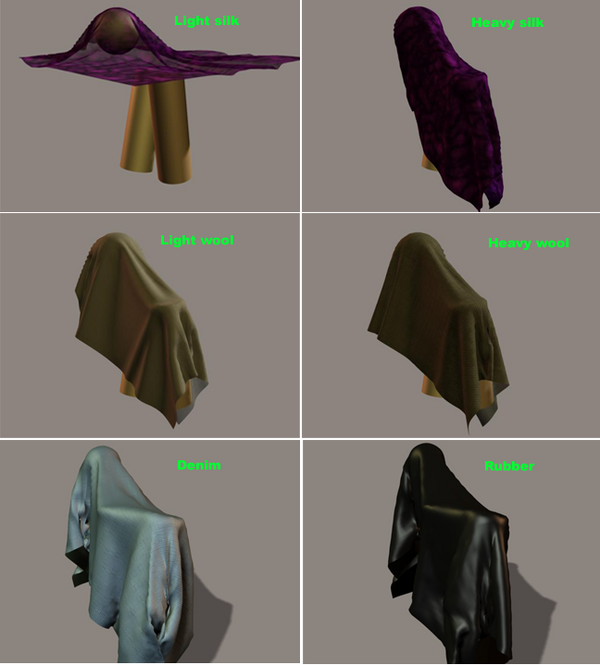|
Explanation of Cloth
Parameters (регуляторы динамики)
In this section we'll describe each parameter
and provide illustrations of the effects of choosing extreme settings. Each
example shows the end product of a 45-frame cloth simulation with all settings
other than those specified being left at their defaults. Note that altering
certain parameters in isolation won't produce the same dramatic results that can
be achieved by adjusting two or more parameters together (cloth density and
dynamic friction, for example.)
Unless a particular effect is needed,
it's usually best to use the default settings; extreme settings (like some of
those shown here) can cause the cloth to behave unpredictably.
|
|

1. Fold Resistance- (сопротивление изгибу)
Определяет сопротивление отклонению от плоскости
This parameter goes from zero to 100; it
determines how 'stiff' the cloth is- as you'd expect from its title, the higher
the fold resistance, the less the cloth can bend when it contacts an object. In
conjunction with the other parameters this can help define how thick the cloth
appears to be
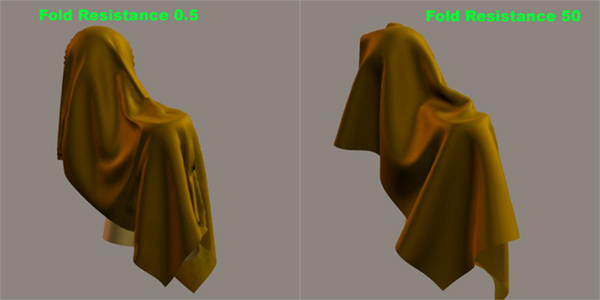
|
|

2. Shear Resistance- (сопротивление сдвигу):
регулирует сопротивление ткани сдвигам в плоскости или отклонениям из стороны в
сторону
Shear resistance has a range of 1 to 1000; it
defines how much the cloth tends to retain its shape as it folds. This differs
from fold resistance; the shear resistance of a fabric determines how much or
little it deforms when actually folding

|
|

3. Stretch Resistance- (сопротивление растяжению):
определяет сопротивление ткани растяжению в плоскости.
This is fairly intuitive; stretch resistance
determines how much the cloth will stretch as it deforms. Its range goes from 1
to 1000. Setting this value very low can actually create interesting effects as
the cloth 'oozes' over the surfaces it contacts. Very high values can make the
cloth more 'wrinkly'. Most fabric should have a fairly high Stretch Resistance.
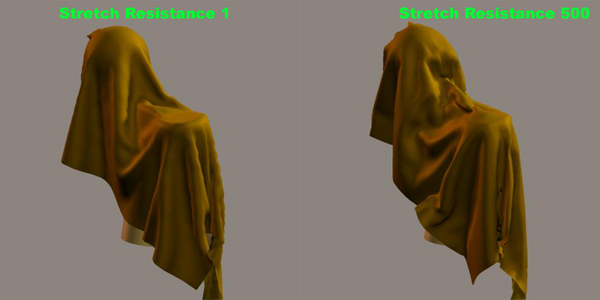
|
|

4. Stretch Damping- (затухание растяжения):
регулирует затухание внутренней энергии обусловленной движением нитей ткани
напротив каждого объекта.
Stretch damping has a range of zero to one. It
works as the fabric stretches- it represents the tendency of the fabric to lose
energy as it stretches, and stay stretched out, versus its ability to snap back
to its original structure. A piece of fabric with low Stretch Resistance behaves
very differently with low versus high Stretch Damping- think of a sheet of
flexible rubber versus a thin layer of tar, for example; both stretch easily but
the rubber regains its shape quickly (it has lower stretch damping) while the
tar, with its higher damping level, stays stretched.
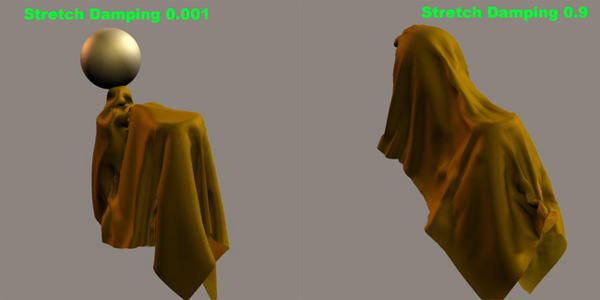
|
|

5. Cloth Density- (затухание ткани):
определяет затухание массы на единицу площади в граммах на квадратный сантиметр.
This parameter accepts values from zero to one; it
represents how much gravity affects the cloth item. This is derived from a
real-world setting for how much the cloth weighs in grams per square centimeter.
Heavier cloth (leather, heavy wool, canvas) would have a higher Cloth Density,
and would behave differently- friction will affect it more, wind force will
affect it less and as the cloth moves it literally will appear heavier.
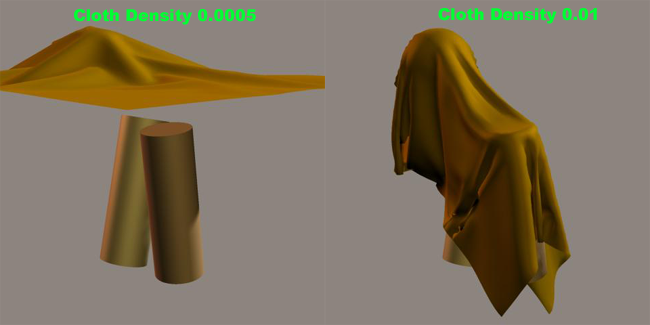
|
|

6. Cloth Self-Friction- (внутреннее трение ткани):
определяет коэффициент трения между двумя частями ткани, иначе говоря, как ткань
движется поверх самой себя.
This parameter also accepts values from zero
to one; it determines how much the cloth sticks to itself, as opposed to the
next two settings which determine how it interacts with other objects.
Self-friction typically has its most visible effect in animations as the cloth
'catches' on itself more as the value is increased.
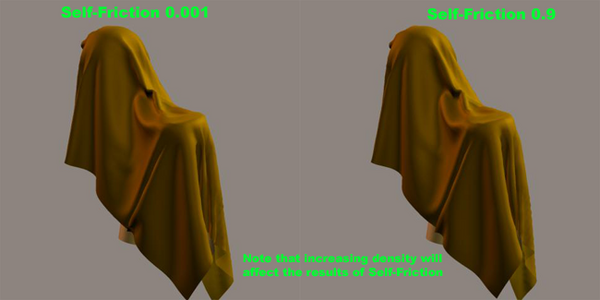
|
|

7. Static Friction- (статическое трение):
определяет силу трения между тканью и твердым объектом.
This parameter accepts values from zero to one;
it determines how much force is required to start the cloth sliding over a
surface from a standstill. The impact of changes in this setting can be
increased by increasing the cloth's density.
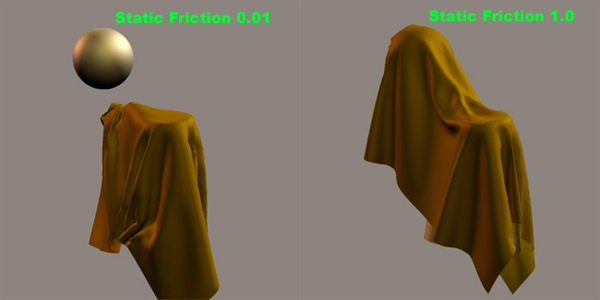
|
|

8. Dynamic Friction- (динамическое трение):
определяет коэффициент трения между тканью и твердым объектом, когда ткань
движется.
This parameter is similar to Static Friction but
determines how much energy is required to keep the fabric moving over a surface.
Like Static Friction its effect may be enhanced or lessened by the Cloth Density
setting.
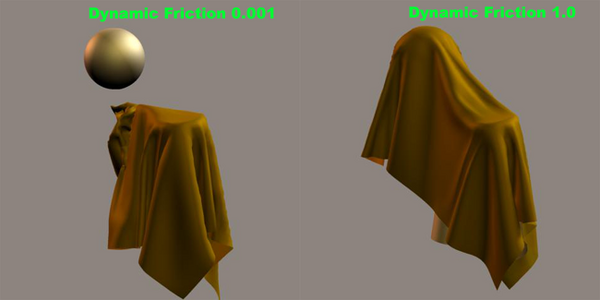
|
|

9. Air Damping- (воздушное затухание):
определяет сопротивление ткани потоку воздуха, которое происходит когда ткань
движется в воздушной среде.
This parameter accepts values from zero to one; it
represents how much influence the 'air' in the scene has on the fabric. Very low
settings allow the fabric to drape quickly and pay less attention to the air-
similar to increasing the density but reducing Air Damping has no effect on
friction. High settings cause the fabric to interact much more with the air, to
the point where it may actually 'float'.
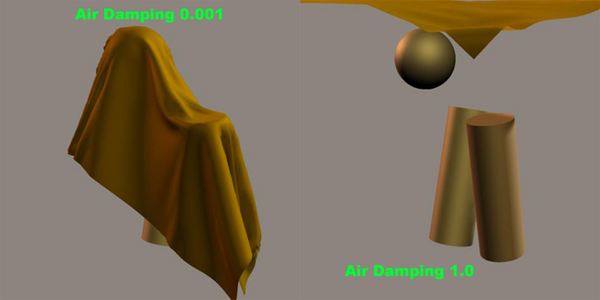
|
|

10. The Collision Friction setting- (трение взаимодействия):
позволяет игнорировать параметры Static Friction и Dynamic Friction тканевого
объекта, используя вместо них аналогичные параметры, принадлежащие самим
взаимодействующим объектам.
This checkbox tells the cloth
engine to ignore the Static and Dynamic friction settings specified by dial and
instead use the settings from the Cloth Collision Objects dialog.
|
Test Fabric
Settings-
| Cloth Sim
Settings & Results |
Fold
Resistance |
Shear
Resistance |
Stretch
Resistance |
Stretch
Damping |
Cloth
Density |
Cloth
Self-Friction |
Static
Friction |
Dynamic
Friction |
Air
Damping |
| Default
Settings |
5 |
50 |
50 |
0.01 |
0.01 |
0 |
0.5 |
0.1 |
0.02 |
| Low Fold Resist |
0.5 |
50 |
50 |
0.01 |
0.01 |
0 |
0.5 |
0.1 |
0.02 |
| High Fold
Resist |
50 |
50 |
50 |
0.01 |
0.01 |
0 |
0.5 |
0.1 |
0.02 |
| Low Shear
Resist |
5 |
1 |
50 |
0.01 |
0.01 |
0 |
0.5 |
0.1 |
0.02 |
| High Shear
Resist |
5 |
500 |
50 |
0.01 |
0.01 |
0 |
0.5 |
0.1 |
0.02 |
| Low Stretch
Resist |
5 |
50 |
1 |
0.01 |
0.01 |
0 |
0.5 |
0.1 |
0.02 |
| High Stretch
Resist |
5 |
50 |
500 |
0.01 |
0.01 |
0 |
0.5 |
0.1 |
0.02 |
| Low Stretch
Damp |
5 |
50 |
50 |
0 |
0.01 |
0 |
0.5 |
0.1 |
0.02 |
| High Stretch
Damp |
5 |
50 |
50 |
0.9 |
0.01 |
0 |
0.5 |
0.1 |
0.02 |
| Low Density |
5 |
50 |
50 |
0.01 |
0 |
0 |
0.5 |
0.1 |
0.02 |
| High Density |
5 |
50 |
50 |
0.01 |
0.01 |
0 |
0.5 |
0.1 |
0.02 |
| Low
Self-Friction |
5 |
50 |
50 |
0.01 |
0.01 |
0 |
0.5 |
0.1 |
0.02 |
| High
Self-Friction |
5 |
50 |
50 |
0.01 |
0.01 |
0.9 |
0.5 |
0.1 |
0.02 |
| Low Static
Friction |
5 |
50 |
50 |
0.01 |
0.01 |
0 |
0.01 |
0.1 |
0.02 |
| High Static
Friction |
5 |
50 |
50 |
0.01 |
0.01 |
0 |
1 |
0.1 |
0.02 |
| Low Dynamic
Friction |
5 |
50 |
50 |
0.01 |
0.01 |
0 |
0.5 |
0 |
0.02 |
| High Dynamic
Friction |
5 |
50 |
50 |
0.01 |
0.01 |
0 |
0.5 |
1 |
0.02 |
| Low Air Damping |
5 |
50 |
50 |
0.01 |
0.01 |
0 |
0.5 |
0.1 |
0 |
| High Air
Damping |
5 |
50 |
50 |
0.01 |
0.01 |
0 |
0.5 |
0.1 |
1 |
Sample Cloth
Settings So, with those parameters in hand, how can we
simulate specific fabrics? Here are a few examples, arranged in a table with
their settings-
| Cloth Sim
Settings & Results |
Fold
Resistance |
Shear
Resistance |
Stretch
Resistance |
Stretch Damping |
Cloth Density |
Cloth Self-Friction |
Static Friction |
Dynamic Friction |
Air
Damping |
| Soft Floaty Silk |
2 |
10 |
40 |
0.010 |
0.005 |
0.000 |
0.200 |
0.010 |
0.150 |
| Heavy Slippery Silk |
3 |
30 |
75 |
0.050 |
0.030 |
0.000 |
0.300 |
0.050 |
0.050 |
| Light Wool |
6 |
60 |
55 |
0.050 |
0.005 |
0.030 |
0.750 |
0.300 |
0.015 |
| Heavy Wool |
10 |
75 |
60 |
0.050 |
0.020 |
0.100 |
0.750 |
0.300 |
0.020 |
| Denim |
8 |
75 |
80 |
0.080 |
0.015 |
0.050 |
0.600 |
0.250 |
0.020 |
| Rubber |
6 |
40 |
20 |
0.020 |
0.010 |
0.010 |
0.750 |
0.300 |
0.015 |
| Default
Settings |
5 |
50 |
50 |
0.010 |
0.005 |
0.000 |
0.500 |
0.100 |
0.020 |
The
results-
|
|
Назад
|
